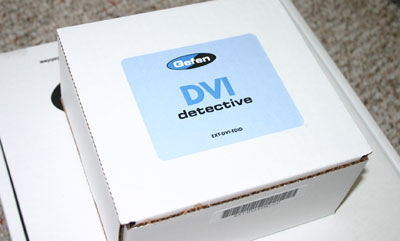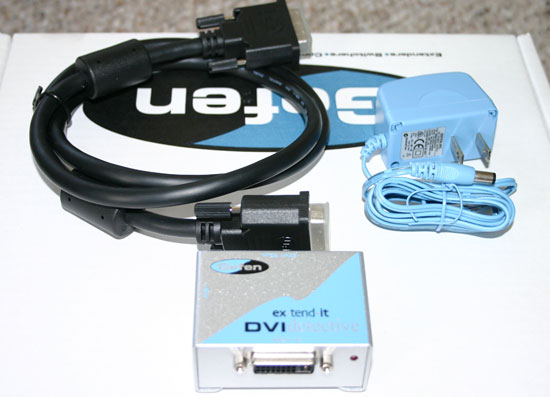Gefen DVI DL: Dual Link DVI + USB KVM
by Anand Lal Shimpi on October 19, 2005 12:05 AM EST- Posted in
- GPUs
Once More, with a DVI Detective
As we mentioned before, Gefen's DVI Detective is a programmable box that will record your monitors EDID information and, once recorded, will continually transmit it to the host machine to trick it into thinking that the monitor is still present.
Luckily, the DVI Detectives solved our OS X problem - now OS X stopped thinking that the monitor was unplugged every time that we switched away from the G5, and we stopped getting screen corruption upon the switch back. Also, with the presence of a DVI Detective on both machines, you no longer have to switch to the machine before starting it up. You can boot both machines without switching to either one, and still have full access as soon as you switch over.
The DVI Detectives also fixed the Cinema Display's USB hub problem. Now we could plug the hub into the DVI DL and switch between systems without losing keyboard/mouse support when switching back to OS X.
Unfortunately, our problems weren't over.
The inclusion of the DVI Detectives meant that we had one extra DVI cable per computer. In other words, the length that the DVI signals had to travel had just gone up by one more cable length. This translated into noticeable visual artifacts on the screen, individual pixels, or often times lines of pixels flickering would be the result.
Fine tuning the EQ knob would always get rid of the flickering, but what we found was that they would return depending on what we had on the screen at the time. The biggest culprit appeared to be playing a DVD. As soon as we'd start up a DVD, we would see many more flickering pixels than before. Part of it was due to the fact that the flickering pixels were more visible on black backgrounds, but once we adjusted the EQ knob to fix the issue on the DVD playback screen, it would return as soon as we stopped playing a DVD. The same applied to various other tasks that we performed on the computer, mostly involving the use of different colors than with what we adjusted the EQ knob originally. The end result was that we could never obtain an artifact-free picture with the DVI DL.
Naturally, we asked Gefen about the problem, and once more, Gefen was very quick to respond - although we weren't happy with their response. Apparently, this is a known problem with the DVI DL, and the engineers at Gefen are working on an auto-EQ that will constantly vary the EQ knob settings in order to fix this problem in all environments. Unfortunately, there is no ETA on the fix, nor is it known whether or not the fix can be retrofitted to current DVI DL units. Should the fix only require a firmware update, Gefen will add the fix to current DVI DL units under warranty. If it is a more substantial upgrade, however, current DVI DL users will have to simply purchase a new unit. To their credit, Gefen offered to refund our money after we asked them about the issue.
As we mentioned before, Gefen's DVI Detective is a programmable box that will record your monitors EDID information and, once recorded, will continually transmit it to the host machine to trick it into thinking that the monitor is still present.



The DVI Detective has rubber feet to prevent it from sliding around your desk.
Luckily, the DVI Detectives solved our OS X problem - now OS X stopped thinking that the monitor was unplugged every time that we switched away from the G5, and we stopped getting screen corruption upon the switch back. Also, with the presence of a DVI Detective on both machines, you no longer have to switch to the machine before starting it up. You can boot both machines without switching to either one, and still have full access as soon as you switch over.
The DVI Detectives also fixed the Cinema Display's USB hub problem. Now we could plug the hub into the DVI DL and switch between systems without losing keyboard/mouse support when switching back to OS X.
Unfortunately, our problems weren't over.
The inclusion of the DVI Detectives meant that we had one extra DVI cable per computer. In other words, the length that the DVI signals had to travel had just gone up by one more cable length. This translated into noticeable visual artifacts on the screen, individual pixels, or often times lines of pixels flickering would be the result.
Fine tuning the EQ knob would always get rid of the flickering, but what we found was that they would return depending on what we had on the screen at the time. The biggest culprit appeared to be playing a DVD. As soon as we'd start up a DVD, we would see many more flickering pixels than before. Part of it was due to the fact that the flickering pixels were more visible on black backgrounds, but once we adjusted the EQ knob to fix the issue on the DVD playback screen, it would return as soon as we stopped playing a DVD. The same applied to various other tasks that we performed on the computer, mostly involving the use of different colors than with what we adjusted the EQ knob originally. The end result was that we could never obtain an artifact-free picture with the DVI DL.
Naturally, we asked Gefen about the problem, and once more, Gefen was very quick to respond - although we weren't happy with their response. Apparently, this is a known problem with the DVI DL, and the engineers at Gefen are working on an auto-EQ that will constantly vary the EQ knob settings in order to fix this problem in all environments. Unfortunately, there is no ETA on the fix, nor is it known whether or not the fix can be retrofitted to current DVI DL units. Should the fix only require a firmware update, Gefen will add the fix to current DVI DL units under warranty. If it is a more substantial upgrade, however, current DVI DL users will have to simply purchase a new unit. To their credit, Gefen offered to refund our money after we asked them about the issue.










30 Comments
View All Comments
johnsonx - Wednesday, October 19, 2005 - link
er... that was supposed to be loses and lose, not looses and loose...but you probably got the idea just the same.
bupkus - Wednesday, October 19, 2005 - link
With an eye for the future, I envision an uber-large LCD I can use for movies, computer games and general computer use. Forget the KVM; I see a single or multiple windows for each computer be it M$ Windows or linux or whatever. I see minimizing all windows, and then maximizing my UT2004 window, or DVD, etc.This is like the X-window systems I recall from college. Now, I'm no expert on X-windows, nor do I expect it could do the job as it is today, but, hey, it'm my freakin fantasy, not yours.
bupkus - Wednesday, October 19, 2005 - link
"it'm"? Man, how did I miss that key so badly? "m" is nowhere near "s". Twitchin' fingers.OrSin - Wednesday, October 19, 2005 - link
Why spend $400+ on switcher. Just by a 20in display for second system for under 400.Yeah its not the great 30in display but who needs 30in for both systems?
Also how can you sell a 400 switch that just don't work.
IronChefMoto - Wednesday, October 19, 2005 - link
Skimming through this article, it makes me shake my head. It's hard to find decent DVI KVMs. The Belkin SOHOs are twitchy at best, and the only other name brand I've been referred to (and actually away from) is IOGEAR.Right now, I use a 4-port VGA/USB KVM for a Shuttle XPC, PC laptop, and whatever 3rd project machine I'm using. After a recent job change that required a switch to a dual DVI monitor Mac, I'm hating having to try and find a decent DVI KVM replacement.
I need a dual monitor DVI KVM if I'm to (a) get a 2nd 17" monitor at home to mimic my work setup and (b) replace my PC laptop with a Mac. I've priced out the dual VGA and single DVI offerings from Belkin's SOHO line, and they're expensive. The dual DVI models from IOGEAR are 30-50% more expensive than those.
For the time being, I'll stick with my single VGA 4-port Belkin SOHO which works fine, after some wrangling. I can't afford a second non-DVI Samsung flat panel anyway, and the Mac laptop is even farther off.
Bottom line -- if you start needing 2 computers, 2 monitors, etc. -- KVMs are gonna get expensive. And that's assuming they don't have bugs like this Gefen did, or like the ones I've read about for IOGEAR products.
IronChefMorimoto
BoBOh - Thursday, October 20, 2005 - link
At work, I have a DVI (not DL) kvm from a company called "Adder". It's flaky with the tilt-wheel mice, but other than that has been flawless. Give 'em a shot.Patman2099 - Wednesday, October 19, 2005 - link
I dont know if macs have similar driver issues, but as far as the DVI detective issue goes, try changing the driver to a pre 5.8 catalyst driver.ive had some screwy issues with DVI on my HTPC since catalyst 5.8 , including things going to hell whenever the htpc loses its connection with the TV(being turned off, changing inputs, etc) before 5.8, everything worked flawlessly and i never had any issues.
Chuckles - Wednesday, October 19, 2005 - link
Anand,I run a slightly smaller scale KVM system between my Mac and PC (12x10 monitor, GeForce 2 MX (Mac), 9600 (PC), Belkin 2-port SOHO DVI KVM). The setup definitely has its quirks and flaws. F13, F15, and the Volume controls on my Apple keyboard no longer register, and about 1/4 of the time, the mouse gets forgotten by the PC.
With regard to the monitor issue, what happens when you hot-plug the monitor into the G5 (without the KVM)?
Also, did you have any peculiarities or restrictions with the keyboard operation when using the KVM?
Lonyo - Wednesday, October 19, 2005 - link
It's not a $600 video card + $2500 monitor + $400 KVM, it's TWO $600 video cards, a $3000 monitor (apparently) and a $400 + $160 KVM, but still as a part of the whole cost, $560 isn't much when you're spending $4000+ anyway.lopri - Wednesday, October 19, 2005 - link
Where can you get a 30" Cinema Display for that price? After adding tax I get a $3,240 quote. Misinformation is as bad as misjudgiment. :~P
Also can you possibly tell me why, oh why, don't other manufacturer's make 30" monitors w/ 25x16 resolution? This has been bugging me so bad. I'd love to have a 30" monitor but I do not want to give a dime to such a greedy company. If Apple can sell 30"s, surely Samsung, LG, Dell, et al. can. Apple is not making the panels on their own anyway. (I believe it's Samsung)
"Market demand" seems to me a weak excuse because these companies make even more expensive (read: $7,000 and up) LCD/Plasma screens. And strangely they are all 1280x768 (or something like that) resolutions. (OK, there are 1900x1080s too, but still way too short of 2500x1600)
Do you have any inside knowledge of this situation? This question's been bugging me for years. (since the 30" CD came out) I'd also like to know if there is any hope to get a bigger res from other manufacturers than Apple in the near future.
Thanks alot.
lop